| Back to Home |
Back to Trinity Trip |
Back to Travel |
The Trinity Site
Some history, along with photos from a recent visit
Some history, along with photos from a recent visit
| Above are some photos
of the plaque, which is emplaced on the obelisk, and of the radiation warning
signs which flank the entrance to the Trinity Site itself. |
||
| Introduction |
A visit to Trinity |
Trinity Photos |
| McDonald Ranch |
How to get there |
Trinity Links |

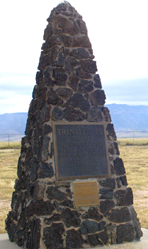
The Trinity site is in southwestern New Mexico, within the White Sands Missile Range. It features several historical exhibits, as well as a marker, in the shape of a stone obelisk, which sits at the center (ground zero) of the site of the world's first nuclear explosion. GPS Coordinates for the obelisk are N33.40.636 W106.28.525. The site is open two days a year, on the first saturday of April, and the first saturday of October. There is no fee charged, the site is handicap accessible, and food, as well as rest room facilities are available at the site. You must have a picture I.D. to get inside of the missile range. Motorists should bring proof of insurance, and of vehicle registration, as these may be requested at the gate. I was not asked for mine. Firearms must be unloaded, and stored, and must be declared at the gate. I had to declare mine. Though I did not see it happen on my visit, automobiles are subject to search. The gate is open from 8:00 AM, until 2:00 PM. Cameras are allowed at Trinity Site; but their use is strictly prohibited anywhere else on White Sands Missile Range.
A View of The Trinity Site - October
7th, 2006
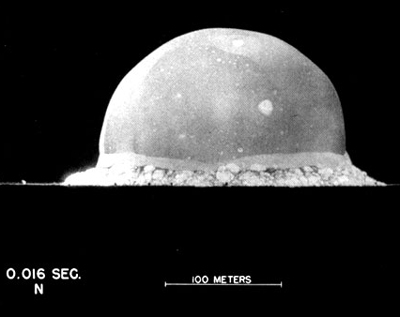
|
On
July 16, 1945, at 5:29 AM, three years of research, experimentation, construction
and sacrifice, at an estimated expenditure of 2 billion dollars (26 billion
in today's dollars), culminated in the successful test operation of a
single device, called The Gadget. This was one of four devices, produced
by what has come to be known as The Manhattan Project. That single moment,
and the genius which had made it possible, changed forever the course
of the world. The test had initially been scheduled for July 4th, to coincide
with the American Independence Day; but complications in preparing "The
Gadget" postponed the test for nearly two weeks. Whatever your feelings
about the aftermath of what happened here, whether you consider nuclear
weapons to be the savior and servant of the west, through deterrence of
aggressors, or whether you see them as grim doomsday weapons, too powerful
for the passions of the humans through which they are created and controlled,
there is no denying that the events which occurred at this spot ushered in
a new era. The shock from the blast broke windows 120 miles away and was felt at least 160 miles away. A flash was seen in far off towns, and a green glow in the sky, like that of the auroras, was seen hundreds of miles away. Military observers, more than ten miles from the site, reported feeling heat from the blast. Rather than the quick flash and bang of a conventional bomb, the "Gadget" took several seconds to complete it's detonation. A half mile wide crater was pushed into the earth. The men at the site, including the designers of the device, felt wonder, awe, and fear, as well as a certain misgiving. This was power outside the range of human experience. The four devices created, from five trigger assemblies produced, including "The Gadget" would come to be known as atom bombs. Their progeny, numbering into the tens of thousands, would be referred to as nuclear warheads. The next two atom bombs to be detonated, would carry the names "Fat Man", and "Little Boy". These devices would be detonated in the middle of urban areas in Japan, and would bring the Second World War to an end. They would also be the last atomic bombs to be distinguished by nick names. By the standards of today, these were all rather small nuclear devices. War was about to be redesigned. Sixty three years after the event, background radiation at the test site is still ten times normal. This despite grading, filling, and the removal of much of the radioactive material. The boundaries of the crater are difficult to discern; but the crater is still there, mostly filled in by the military, and by drifting sand over the years. Local residents recall that after the end of the war, the Trinity site was abandoned. Buildings, barracks, the ranch house in which the bomb was assembled, unused military vehicles, and even the crater itself, looking something like a gigantic shallow bowl of green jade, stood empty, and unguarded, for years. In late 1945, the Manhattan Project was disbanded and became the Atomic Energy Commission. The crater of green glass remained untouched until 1953, when the AEC had the site cleaned up and the green glass buried several miles south of the site. The crater, 2400 feet in diameter, and ten feet deep, was then filled in and graded. A fence, today known as the outer perimeter fence, was erected, and signs were posted restricting the site. In 1965, the stone obelisk was constructed at ground zero. In 1975, The Trinity Site was declared a national landmark, and included 51,500 acres of land around ground zero. The first public open house of the area, other than those arranged for the press, military, or scientists, was in September of 1953, and was attended by about 650 people. In 1967 the inner oblong fence was added. In 1972 the corridor barbed wire fence which connects the outer fence to the inner one was completed. Jumbo, a large steel casing, which had withstood the blast from 800 yards downrange, was moved to the parking lot in 1979. There have been regular yearly open houses since at least 1980. Because of the increasing crowds showing up at the annual open houses, the site was opened to the public twice a year, starting in 1985. Visitation presently stands at around two to three thousand people per open house. These numbers grow every year. The events which led to this moment, were set in motion by a letter, written to The President of the United States, by Leo Szilard, and Albert Einstein. This was delivered October 11, 1939, on the eve of what was to become the Second World War. The letter expressed concern that there were great discoveries being made by German scientists, and that nuclear fission had been achieved in that country. It was suggested that, should Nazi Germany develop an atomic bomb, and be the only power so armed, the rest of the world would be helpless before it's might. It was further suggested that the United States make an effort towards developing it's own atomic bomb, while there was still time. In point of fact, the letter was ignored, and a couple of years passed before America, influenced by developments in the United Kingdom, set about the task of developing nuclear weaponry. The Manhattan Project really began on September 17, 1942, though the history books give it's official beginning as being June 1942. In September, General Groves was given, besides his promotion to Brigadier, carte blanche to use whatever resources, and whatever methods he might determine best, to develop nuclear weapons, and get them produced for use in the war. This is a fascinating story, in it's own right, and volumes have been written on the massive effort, resources, and power set to this task. The validation of all of these efforts rested upon a single event, which lasted a few seconds in the desert of New Mexico. "The Gadget" was not a bomb, in any real sense of the word. It was a precision built nuclear device, hand made by scientists and engineers. The three devices which were to be produced after it, were built with equal attention to painstaking detail; but were housed in bombshells, and designed to be dropped from airplanes. "The Gadget" was a plutonium implosion bomb, similar in design to the Fat Man bomb. It relied upon explosive lenses, surrounding a hollow plutonium core, to compress the core to the point where it became supercritical. This is the path of development taken by nuclear weapons designers, and comprises the overwhelming majority of nuclear warheads, and nuclear triggers in use today. Plutonium does not exist in nature, and is created in reactors, by bombarding uranium with neutrons. Uranium based nuclear weapons are very rare, though uranium is the preferred fuel for nuclear reactors. The second atom bomb, Little Boy, was a uranium based nuclear weapon. A decade latter, hydrogen fusion bombs, so called thermonuclear warheads, were developed, which could be made well over a thousand times more powerful than the device detonated at The Trinity Site. Indeed, these larger devices were tested on remote islands in the Pacific Ocean. The highest yield U.S. nuclear warhead was the 25 MT W-41. This is right around 2,000 times more powerful than the Trinity, or Fat Man devices. The soviets developed a 50 MT bomb. In theory, there is no limit to the potential yield of a thermonuclear weapon. Pure fission devices have a limit of something like a half of a megaton. 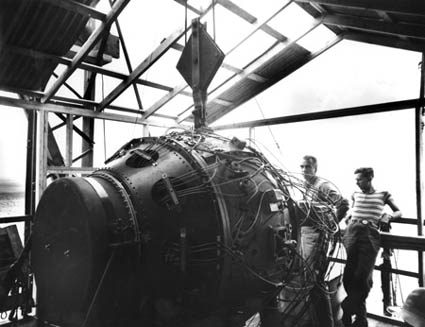 The photo to the left was taken from the official archives of the Trinity
Site, and shows "The Gadget" as it was being prepared for ignition.
The photo to the left was taken from the official archives of the Trinity
Site, and shows "The Gadget" as it was being prepared for ignition. The photos running down the left hand side of the page are taken from the same source, and show the device in various stages of detonation. |
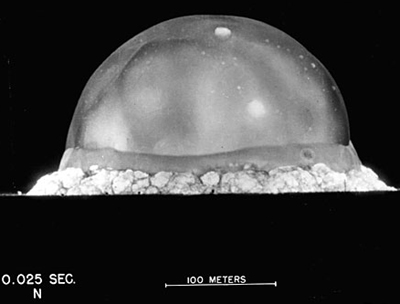
|
|
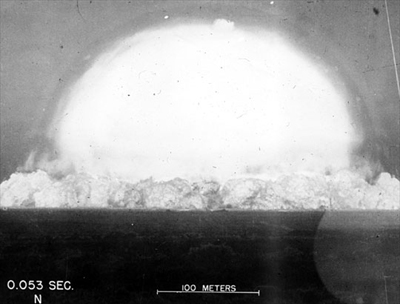
|
|
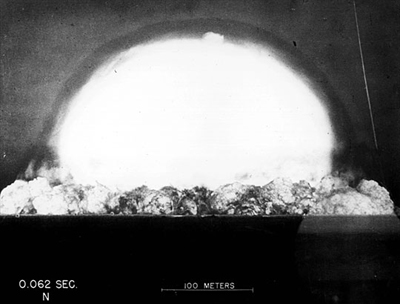
|
|
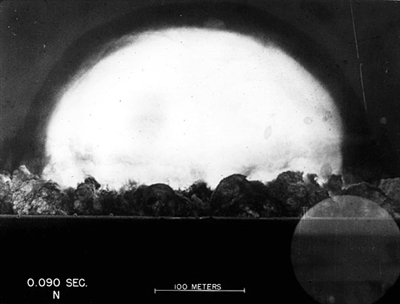
|
|
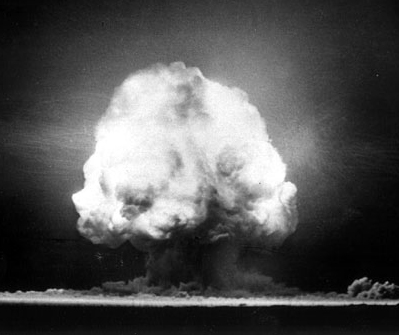
|
Twice a year, on the first Saturday of April, and again on the first Saturday in October, the public is permitted to visit what may ultimately turn out to be the most important historical site in the
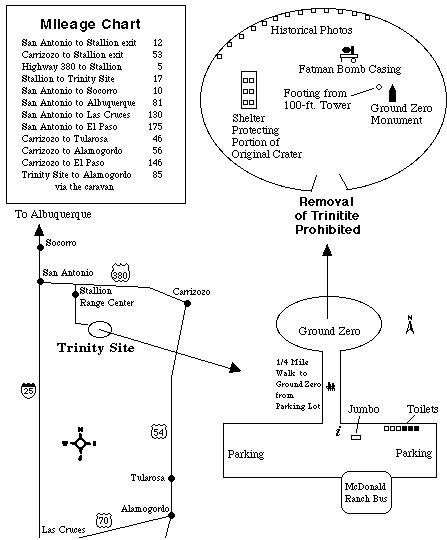 world. This is the Trinity site, a part of the White Sands Missile Range,
located in one of the most desolate parts of the country. The place doesn't
look like much. In point of fact, it doesn't look like anything at all.
If you are looking for the spectacular, the beautiful, or for a pristine
work of nature, you will be disappointed. Go to Yellowstone instead, or perhaps the
Grand Canyon. Trinity is for those
who are looking for something a bit different. Life is not made to feel
welcome here, and it exists, not on it's own terms, but only by making many
concessions to the environment.
world. This is the Trinity site, a part of the White Sands Missile Range,
located in one of the most desolate parts of the country. The place doesn't
look like much. In point of fact, it doesn't look like anything at all.
If you are looking for the spectacular, the beautiful, or for a pristine
work of nature, you will be disappointed. Go to Yellowstone instead, or perhaps the
Grand Canyon. Trinity is for those
who are looking for something a bit different. Life is not made to feel
welcome here, and it exists, not on it's own terms, but only by making many
concessions to the environment.This is a rather unusual attraction, hardly the kind of place that you think would draw thousands of visitors, on each of the two days a year that it is open. Unlike the more conventional national parks, civil war battlefields, nature preserves, and national monuments, this most unconventional tourist attraction, seems to attract a most unconventional type of tourist. It is not a place for a casual visit. In addition to only being open two days of the year, the site is in the middle of a military preserve, far from any other points of interest, and so far off of the beaten path, that not only is it difficult to find; but you will need to make certain that you have a full tank of gas before embarking. During the popular 170 mile round trip from Alamogordo, there are no services, gas stations, restaurants, or anything else.
What you see here is a piece of desert, like countless other pieces of desert. It is hot, most of the time, barren all of the time, featureless, flat, and actually kind of dull, at least based upon superficial appearances. In order to get a feel for the real importance of the place, you have to look a bit more closely. There is the Obelisk, of course. It stands right at the center of ground zero, where the detonation actually took place. The peaked top seems to point to the location of the original atomic bomb, which was detonated 100 feet overhead, suspended from a gantry. The obelisk was erected by White Sands Missile Range in 1965 and is made from lava from the west boundary of the range. Though the heat of the nuclear explosion created Trinitite, the famous green glass of the nuclear age, rather than lava, the choice of materials seems quite appropriate.
The desolation of the place is no accident. The Army didn't want people around. Decades latter, two days of the year not withstanding, it still doesn't. One of the best ways to make certain that there are no people around, is to go someplace where they are already absent. This describes the desert of southern New Mexico pretty well. In addition, the place is well watched, well guarded, and it's boundaries are prominently marked with warning signs. Scorpions and other creatures of the desert take no note; but humans need to keep out, except for the semi annual open houses.
In my own case, I left early from the little town of Carizozo, NM. The town is located at the crossing of highways 380, and 54, in south central New Mexico. I had been considering a trip out here, for at least five years, ever since I had first read that the Trinity Site was open to the public. I had made this discovery, while researching what was to be a trip to the Minuteman Missile NHS. This, in turn, was discovered, while browsing the National Park Service website, in preparation for a summer vacation. I had assumed, correctly, that the Trinity site was restricted, and not open to the public. What I learned on the web was that the White Sands range opens the site, twice a year.
So at 5:40 in the morning, I was up, and hitting the shower. Dressing, and packing up my motel room, I noted that it was just after 6:00 AM. I poked my head out of the door, and took a picture of the intersection of highways 380, and 54. It was still pretty dark out, and I fought the urge to crawl back into bed. I had been up pretty late the night before, not having fallen asleep until midnight or so. The motel room was large, comfortable, had cable, and a refrigerator as well as a microwave. I had checked in very early, around 1 PM, and spent the day lazing around. Cable was showing a series of westerns, including Pale Rider, ElDorado, and Butch Cassidy and the Sundance Kid. Being in the Southwest, I felt a particular urge to watch all of these; but worse was to come. In the evening, the movie "Them" was shown. For those who are unfamiliar with the old fifties science fiction movies, the movie was set in southern New Mexico, and the plot revolved around a nest of gigantic ants, which were given their great size by being located too close to ground zero at the Trinity Site, the very place to which I was going.
Around 6:30, I was finally ready, had microwaved myself a little breakfast, and had everything packed into my van. It was time to go. There was just a hint of light, in the cloudy sky, and the air was cooler than you would expect for New Mexico. All along the drive, I saw few cars, and no signs of what we like to call civilization, other than the road itself. I also saw no giant ants, no oversized grasshoppers, and no titanic tarantulas. Indeed, I saw no indications of mutants of any kind, unless they were mutated into invisibility. What I did see were incredibly deep indigo skies, and gold colored ground. These are not colors the way that they appear in my home state of Wisconsin. We tend to have more greens and browns, with a bit lighter shade of blue to our skies.
Reaching the turn onto highway 525, after an hour of driving, I drove on a few miles, and saw my first indication that anything special was going on. An MP stood in the road, with an M-16 rifle. His truck was pulled to the side of the road, and there were some cones in place. He was quite friendly, and asked if I was going to the open house. He then explained that I should have my picture I.D. ready at the gate, and that I would need to declare any firearms that I had with me. Along the way, I saw numerous armed men. All were friendly, and seemed more like guides than guards. Still, guards they were. It was their job to insure that no one went into any areas of the range, other than the Trinity Site. I easily resisted the impulse to take their photographs. There are some things that you just don't do.
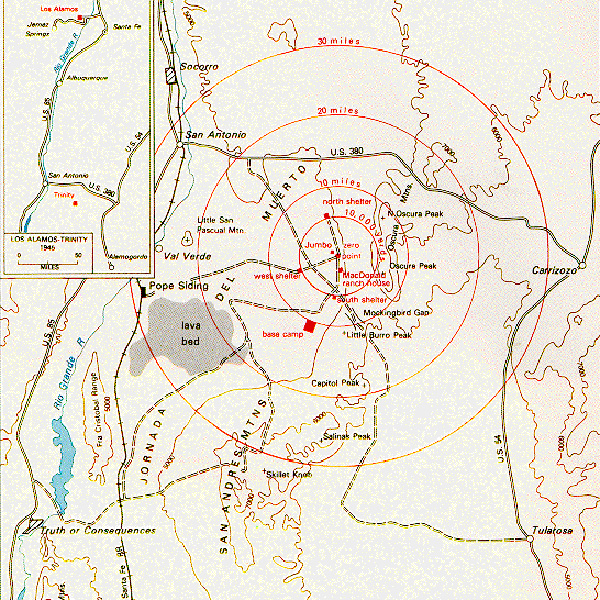 I was about ten minutes early, at Stallion Gate,
and there was a line of about twenty cars ahead of me, waiting for the
gate to open at 8:00. We were met at the gate by MP's, and by volunteers,
who passed out leaflets, and brochures. I was asked for my I.D. and if I
had any firearms. When I admitted that there were two 45 automatics in a
case, in the back of my van, I was ushered to the side of the road, where
my license plate number was recorded. The MP then told me that there was
no problem, and that I was welcome to pass through, but that I needed to
leave the guns cased, and unloaded. The only thing close to a problem I had
was when he saw me raise my camera to take a picture of the gate. He shook
his head, and warned that photographs taken within the range, other than
at the Trinity Site itself, would be cause for confiscation of my camera,
and detainment. The military is pretty serious about this. There are still
secret tests, and weapons development being carried on out here, and it is
a rather touchy thing, allowing numbers of civilians onto a working missile
range. Even if I mean no harm, you never know where a picture might end up,
who might see it, or what might be learned from it's display. Needless to
say, I put my camera in it's bag, and latched it shut. I did not come all
this way, to spend a day sitting at a table explaining to a range officer
why I took pictures of things that were not to be photographed.
I was about ten minutes early, at Stallion Gate,
and there was a line of about twenty cars ahead of me, waiting for the
gate to open at 8:00. We were met at the gate by MP's, and by volunteers,
who passed out leaflets, and brochures. I was asked for my I.D. and if I
had any firearms. When I admitted that there were two 45 automatics in a
case, in the back of my van, I was ushered to the side of the road, where
my license plate number was recorded. The MP then told me that there was
no problem, and that I was welcome to pass through, but that I needed to
leave the guns cased, and unloaded. The only thing close to a problem I had
was when he saw me raise my camera to take a picture of the gate. He shook
his head, and warned that photographs taken within the range, other than
at the Trinity Site itself, would be cause for confiscation of my camera,
and detainment. The military is pretty serious about this. There are still
secret tests, and weapons development being carried on out here, and it is
a rather touchy thing, allowing numbers of civilians onto a working missile
range. Even if I mean no harm, you never know where a picture might end up,
who might see it, or what might be learned from it's display. Needless to
say, I put my camera in it's bag, and latched it shut. I did not come all
this way, to spend a day sitting at a table explaining to a range officer
why I took pictures of things that were not to be photographed.There is a 17 mile drive, through the missile range, to the Trinity Site. This is along a narrow two lane road, which winds it's way through hills, and desert. There are occasional intersecting roads, which were all coned off. From time to time I would see an MP, security guard, or military vehicle. Still, there seemed to be little overt military presence, though I have no doubt that the visitation was being monitored. Upon reaching the site itself, the first thing I saw was a large parking lot, with chalk lines marked out along it's length. We were directed to parking spots, and helped to line up our vehicles. Once I was properly parked, I loaded up my camera, and headed for the perimeter fence.
There are two fences surrounding the Trinity Site. The outer fence is about a half mile in diameter, and is approximately at the boundary of the crater. The inner fence is much smaller, and encloses ground zero, the obelisk, a shed which opens to the original crater floor, some photographic exhibits, and what is left of the tower legs. There are also some other displays, including an early fat Man style atomic bomb casing. Between the two fences is a fenced in walkway. When you reach the site, you are walking on about ten feet of sand and soil, which covers the original crater floor. Approaching the inner fence, you pass a tent which houses a radiation exhibit, and is staffed by some of the radiation safety personnel of the range.
Around the outer fence, is an information booth, "Jumbo" a huge steel cylinder which was 800 yards from the blast, a stop for a pair of buses which run visitors out to the McDonald ranch, and a food concession. The food was pretty good, and was not real expensive either. In the old days, visitors were not allowed to eat, smoke, or even to apply makeup at the site. This was due to fear of ingestion of any radioactive dust that might have been blowing around. After sixty years, though, any radioactive dust that is going to blow around has probably already blown away, or lost it's radioactivity. So now you can get yourself a nice hot dog, hamburger, bag of chips, and soft drink, before going into the inner perimeter.
Visitors to the site were a varied lot. I heard a few foreign languages, but for the most part, visitors were American. I saw one girl who was obviously Japanese, though hardly old enough to have witnessed the nuclear detonations in her own country. I saw a large portion of older people at the site, and very few really young people. Most tended to range from middle age to elderly. I also noted several veterans groups, which is pretty understandable. At least one of these groups appeared to have been old enough to have served in W.W.II. People were very friendly, and very outgoing. I noticed little of the solemnity which I had half expected. Visitors were enthusiastic about the radiation exhibit, very entertained by Jumbo, and seemed entranced by the obelisk itself. Everyone seemed to want to touch it's rough lava surface. I saw people leaning up against it, and pushing at it, rubbing their hands across it. Eventually a line formed, of those who wished to have their photo taken next to the obelisk. The whole picture taking thing seemed a bit pretentious to me, sort of like getting the picture of aunt Mary, and uncle Bill standing in front of Old Faithful, or the Grand Canyon. So I didn't join in. Now I wish I would have.
After spending some time with the radiation ladies, and their Geiger counters, I wandered back outside the outer fence, and looked at Jumbo, before hopping one of the buses, for the McDonald ranch house. This was the place where the bomb was actually assembled, and has been restored to it's approximate condition, during the test. The ranch is a comfortable looking stone structure, and was probably a pretty nice home, before the area was evacuated for the military. I gawked a bit, looked at all of the photographs, and wandered around the house. As with the obelisk, many visitors wanted to have their photos taken in front of the house. Though the house is completely restored, it is not furnished, and contains a few chairs, and the tables holding the displays. After about half hour or so, I took a bus back to the main site.
Returning to the main area, I took one last stroll around the site, snapped a few more photos, and grabbed myself something to eat. I had spent about three hours here, total, and the place was now starting to fill up. The convoy had arrived from Alamogordo, as well as at least two buses, probably from Albuquerque. It was time to go. Picnic tables were set up, so that I could relax, and enjoy my meal, as I watched the people go to and around the site. A few seemed to feel the weight of what had happened here; but most were excited, happy, and very curious. I noticed that a large proportion of the men had hats, ties, jackets, or pins indicating former or current military service. Many of these men were older , and walked with the aid of canes, walkers, or simply used the shoulders of friends to lean upon. It made me wonder which wars they had served in, and what connection, if any, they might feel with the weapons which were proven here. Too much introspection is a certain indicator that it is time to leave.
| ABOVE: The gate in the outer fence is flanked by radiation warning signs. It also displays the mileage to nearby cities, and is home to an information booth. LEFT: In case it feels as if you are in the middle of nowhere (you are), and you are wondering where in the world this place is, this sign, posted just to the left of the outer fence gate, will tell you. |
|
| If you are wondering about anything else,
or just need directions, this is the place to go, flanking the right side
of the gate in the outer perimeter fence. |
|
LEFT: Another good source of information, and of brochures, and hand outs, is the information booth, right at the gate of the outer fence. BELOW: The walk form the outer fence, to the inner fence, is about a quarter mile. The ground upon which the path runs is fill over the actual crater. |
|
ABOVE: A motorized transport is available to take those who are unable to make the walk, to the inner area. LEFT: Approaching the inner fence. The tent to the right of the photo, houses the radiation safety exhibit. |
|
| At the inner fence, a sign plainly sets
out the official policy regarding the collection of trinitite. |
|
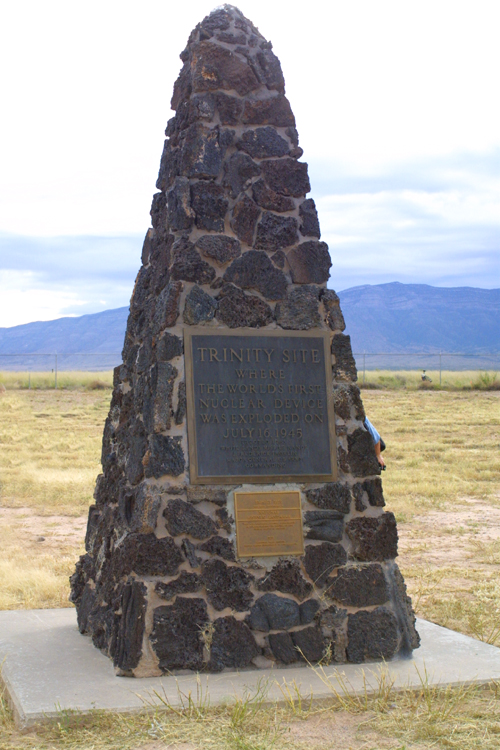 Click on this photo for a larger view
Click on this photo for a larger view |
LEFT: This is the obelisk. It has become the icon of the Trinity Site, and is set exactly at ground zero. It is constructed of Lava, taken from a lava field in the western section of the missile range. It was erected in 1965. The black plaque, at the "Front" of the obelisk commemorates the Trinity test. The gold plaque below signifies the date that the area became a nation landmark in 1975 BELOW: This is my favorite photo of the obelisk. The man in the photo came with one of several veterans groups who visited the site. I don't know if this man is a W.W.II vet or not; but it certainly feels as if he was. I wanted to speak to him; but something very personal seemed to be going on here, and I didn't want to interrupt. It is claimed that as many as one million American lives were saved by the dropping of the nuclear bombs on Japan. Perhaps his was one of them. |
| These little nibs sticking out of the
ground are all that is left, of the hundred foot steel tower from which
the "Gadget" was suspended during detonation. The rest of the tower was
vaporized, not just blown to bits, but actually turned into gas. |
|
| In the middle of this stark landscape,
the obelisk draws visitors like a magnet. It would be an imposing structure
in any setting; but here it is particularly striking. |
|
| A girl stands to have her photo taken
next to the obelisk. She is just one of many. Everyone wants to be photographed
next to the ground zero marker. |
|
| A couple have come to the site together,
and are photographed standing to either side of the obelisk. A line is forming
for those who wish to have their pictures taken next to the marker. |
|
| People continue to line up, and congregate
near the obelisk. Everyone is taking pictures, and people are taking turns
standing next to the marker. |
|
| A look from behind the obelisk, towards
the entrance to the inner fence. It is probably about 9:30, and the group
from Alamogordo has yet to arrive. By noon, this whole area will be filled
with people.. These events generally draw 2000 to 3000 people. |
|
| The perimeter fence is adorned with plaques,
photographs, and historical facts, on placards. These visitors are going
up to inspect them. The slope of the land is pretty evident, looking towards
the fence. |
|
| This is the shed. This whole area was originally
a blast crater, which measured ten feet deep by 2400 feet in diameter.
It was lined with radioactive trinitite, which is the green glass formed
by the heat of the explosion acting upon the sand of the desert floor. Most
of the trinitite was scraped up, and removed from the site. The crater was
then filled in and graded. The shed is buried up to it's roof line, and sits
on the actual floor of the crater. A door in the roof allows viewing of the
small section of crater floor within the shed. |
|
| I call these representatives of the range
radiation safety team, the radiation ladies. They were housed in a small
tent, just outside of the entry to the inner fence. It was a pretty interesting
display. Geiger counters measured radiation from an assortment of objects,
including some trinitite retrieved from the site. Visible in this photo
are some old clocks with radium markings, and a smoke detector which uses
a bit of radioactive material to interact with a sensor. In truth, smoke
detectors are actually radiation detectors. When smoke passes between the
radiation source, and the detector, it reduces the radiation hitting the
detector face, and sets off the smoke alarm. |
|
| The clear box with the radiation warning
label holds a variety of trinitite specimens. These evoked a satisfying series
of clicks from the Geiger counters. The marbles in the jar, as well as the
juicer, and some other articles, were produced decades ago, when uranium
was used as a glazing and coloring agent in pottery and glassware. At one
time, back before the nuclear age began, uranium glass was quite a popular
item. Also found to be radioactive are cigarettes, and some food items.
|
|
| Just outside the outer perimeter fence,
stands the food service. |
|
This is Jumbo. Jumbo was designed and built in Ohio. Originally it was 25 feet long, 10 feet in diameter and weighed 214 tons. The ends are missing because, in 1946, the Army placed eight 500 pound bombs inside of it, and detonated them. Too bad, really, because it would have been rather reassuring to have seen something which had survived a nuclear blast. Of course, when visitors see it, most assume that it was the Trinity detonation which blew the ends off, and left the scars on the metal. |
|
| Jumbo seems to hold a real fascination for
visitors, second only to the spell cast by the obelisk itself. The big piece
of metal was crawling with people, who wanted to get inside of it, walk around,
bang on the walls, and feel it's edges. It took me a moment, but then I
realized where I had seen such behavior before. When my little brother was
much younger, he had a bunch of gerbils. This was the exact way that they
would act, when presented with a cardboard or plastic tube. |
|
| LEFT: Jumbo lies close to the area where the cars are parked, and is off a bit, from the entrance of the outer fence. A piece of the "Jumbo" bomb casing was given to Socorro, which was unveiled on the Socorro Plaza by the Chamber of Commerce as part of the "Free State of Socorro" celebrations. Highway signs were erected declaring Socorro as "Home of the Trinity Site." This was done primarily to counteract Alamogordo's claims BELOW: The official aerial photographs of the site as it appeared right after the test, and as it appears today. |
|
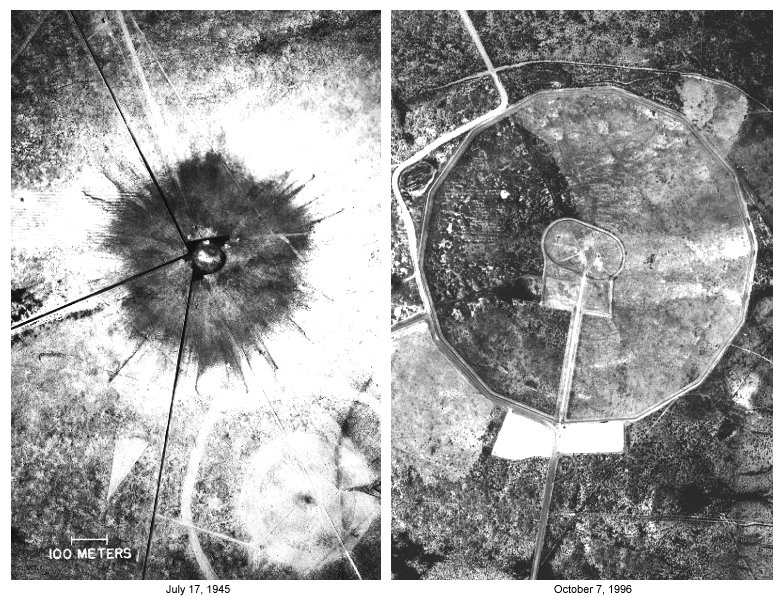
| The McDonald Ranch House is where the
bomb was actually assembled, before it was hoisted up the tower, and detonated.
The site has several buses, which spend the day shuttling visitors back
and forth, the two mile trip between the ranch house, and the main site.
|
|
| My first look at the McDonald ranch. It
sits on a small rise, with as much vegetation as can be found in these parts.
To the left is the tower atop which the old water tower stood. To the right
is the tower which had held the windmill. During the days when this site
was being prepared for the Trinity shot, the water tower was used as a swimming
pool. |
|
| Inside of the house, displays, and exhibits
try to explain just what happened here. The house is about two miles from
the site. This is where the bomb was actually assembled. In point of fact,
the room in which this photo was taken was the bomb assembly room. |
|
| Feeling a bit like house hunters, we wander
from room to empty room. Though all of the windows were blown out, and some
damage was done by the nuclear explosion, two miles away, the stone house
remained structurally sound. Years of neglect, and a leaky roof put the house
in serious disrepair. Eventually the National Park Service was provided with
funds to fix the house up, and restore it to it's approximate condition at
the time of the Trinity shot. |
|
| A look out towards the mountains, from
the front porch. The water tower platform stands in the midground. visitors
mill around everywhere, exploring the grounds. The house and grounds were
taken over by the Army, after the entire area was purchased and evacuated
for use as a test site. |
|
So was it worth the trip? Absolutely! There is a sudden realization that comes, after milling about the place for a while, of what actually happened here, and of what has happened in the decades since, because of what happened here. So would I go back? Probably not, at least not by myself. It is the kind of place that I would take children, grandchildren, or interested friends; but not the kind of place that I need to see again for myself. Once you have seen the site, you have seen it for life.
While the Trinity site is not hidden or secret, there is restricted entry, and the the whole area is rather secluded. The nearest town, that of Socorro, is 43 miles away, over two lane roads which twist through mountains and desert. The city of Alamogordo, which is considered by most to be the gateway to Trinity, is 85 miles away. For those who worry about being lost, or about mechanical breakdowns, a caravan leaves Alamogordo at 8:00 A.M., from the fairgrounds. There are also buses going out from several locations. I have listed the bus tours offered, and prices in the table below; but please contact the groups to make certain, since things are always subject to change. There are, doubtless, other tours being offered; but these are the ones of which I am aware. Most tours offer other stops, lunches, movies, etc. Please call contacts to get details.
| Organization |
Cost |
Location |
Time |
Contact |
| National Atomic Museum |
$55 |
Albuquerque, NM |
6:00AM |
Call (505) 242-6083 |
| Sigma Pi Sigma (U.N.M.) |
$40 |
Albuquerque, NM |
7:00AM |
Call (301) 209-3007 |
| Chamber of Commerce |
$10 |
Socorro, NM |
8:00AM |
ctiegs@admin.nmt.edu |
| Chamber of Commerce |
$35 |
Alamogordo |
(800) 826-0294 |
Taking the Caravan
A group meets at Alamogordo, NM, for a caravan
drive out to the Trinity Site. The group forms at the Otero County Fairgrounds
parking lot on U.S. 54/70 in Alamogordo. This is probably the most popular
way to get there. The Alamogordo Chamber of Commerce sponsors the convoy.
Line up begins at 7:15, and the convoy leaves at 8AM.. Visitors entering
this way will travel as an escorted group to and from Trinity Site. The
drive is 170 miles round-trip and there are no service station facilities
on the missile range, so you will want to tank up before leaving. This
tour will enter through the Tularosa Gate at 8:30AM, and arrive at Trinity
Site around 10:00AM. The convoy is scheduled to leave Trinity Site at 12:30 or 1 PM., depending upon its size, for the return to Alamogordo. The convoy may leave later if there are a large number of vehicles returning to Alamogordo. Visitors wishing to stay a bit longer may do so; but will need to exit through the Stallion gate, as the Tularosa gate is only open to the convoy. For information, call 505-437-6120 or 800-826-0294.
Driving by Yourself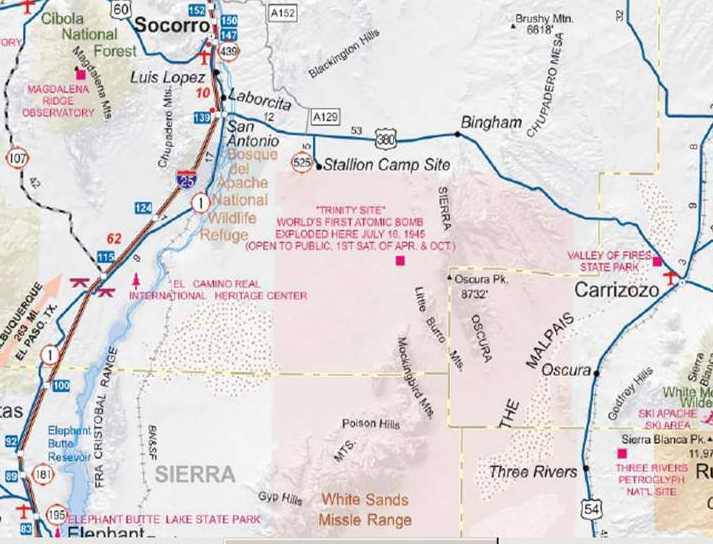
The Trinity Site is located within the White Sands
Missile Range, 22 miles off of Highway 380. This is a different entrance
from the one used by the Alamogordo caravan. Though I was a bit concerned
about the possibility of getting lost or stranded, this did not turn
out to be a problem. Mapquest could not find the Trinity site, nor the Stallion
gate; neither could the GPS mapping system (Microsoft Streets and Maps)
installed on my laptop. In addition to this, the location is marked on the
New Mexico state map; but the roads and paths were not shown at all. I have
included a scan, to the right, of this area of the official highway map,
for the state of New Mexico. As can be seen, the map is just a big blank,
once you get off of Highway 380. Using the GPS coordinates, I Was able
to get the location to show up in my mapping program; but it could still
not find the roads, nor map me a route. With a certain amount of trepidation,
I left my motel room, at 6:30 AM, and started on what I hoped was the way
to Trinity. 
I need not have worried. The route was easy, and direct. Simply stay on highway 380, until it meets New Mexico 525 South. And then take 525 to the Stallion Gate. The turnoff point is located about 12 miles east of San Antonio, NM, and 50 west of Carizozo, NM. It is clearly marked, on the road if not on the maps, and is nearly impossible to miss. So don't worry about it; just go. It is five miles down NM 525, from highway 380, to the Stallion gate. From stallion, it is another 17 miles to Trinity. Once you are within the missile range, there will be signs and the roads will be blocked off, except for the road to Trinity. The military does not want visitors getting lost on the range any more than the visitors do themselves. Though the drive turned out to be pretty simple, I have posted photos and directions anyway, in part because the way is so scenic.
Driving to Trinity
| If you don't believe in magic, try taking
Highway 380 through New Mexico at 6:30 in the morning. This was the start
of a 75 mile, hour and a half drive from Carizozo to Trinity. |
|
| This is the desert, though it has it's
own abundance of specially adapted flora and fauna. In contrast to many of
the movies with which I grew up, there were no giant insects, or flying saucers
out here. Even so, a hundred or so miles from here, Rosewell, NM claims
to be the UFO capitol of the world. |
|
| Rolling down into a great bowl of a valley,
as the sun rises. The direct light turns the parched ground gold. |
|
| I can not say how relieved I was to see
this sign. Judging from my maps, I was certain that I would pass the turn
off, and end up having to come back down from San Antonio. |
|
| A historic marker, and adjacent
pull out, both across the road from the sign pictured above, serve notice
that you are at the access point for the Trinity Site, and commemorate
the events that occurred there. |
|
| Now on 525 South. Five miles down this
road, is the Stallion gate, and entry into the White Sands Missile Range. |
|
| If the local highways were a bit empty,
the roads through the missile range were desolate. Sitting atop the
hill in the center of the photo is a radar dome. I saw many such things,
along with antenna arrays, telemetry systems, bunkers, and blockhouses.
I have photos of none of them. The men at the gate were quite adamant about
the fact that were I to be seen taking photos outside of the Trinity area,
my camera would be taken, and I would be held. This photo was taken from
just outside the range. |
|
| It is about ten minutes before 8:00 AM
here, and some people are already lined up at Stallion gate awaiting the
8:00 AM opening. I counted about 20 cars ahead of me. |
|
| The gates have just opened, and are visible
just ahead. This is the last photo that I will be allowed to take, until
I reach the Trinity Site. |
Trinity Links
Needless to say the Trinity site, The Manhattan Project, and the whole subject of nuclear weapons, physics, and atomic energy are fascinating subjects, and have generated numerous books, movies, and websites. Below are a few that I visit, and some that I have used in researching for my trip, and for this page. Particularly fascinating is the High Energy Weapons Archive, listed below, which has history, descriptions, and photographs of just about every nuclear weapon ever deployed. It also contains a great section explaining the different types of devices, how they work, and how the various materials which go into their construction are produced. In addition to this, it contains a number of photographs, and movies, of actual nuclear explosions. One other great source of nuclear information, and photographs, is the book 100 Suns, by Michael Light.
Needless to say the Trinity site, The Manhattan Project, and the whole subject of nuclear weapons, physics, and atomic energy are fascinating subjects, and have generated numerous books, movies, and websites. Below are a few that I visit, and some that I have used in researching for my trip, and for this page. Particularly fascinating is the High Energy Weapons Archive, listed below, which has history, descriptions, and photographs of just about every nuclear weapon ever deployed. It also contains a great section explaining the different types of devices, how they work, and how the various materials which go into their construction are produced. In addition to this, it contains a number of photographs, and movies, of actual nuclear explosions. One other great source of nuclear information, and photographs, is the book 100 Suns, by Michael Light.